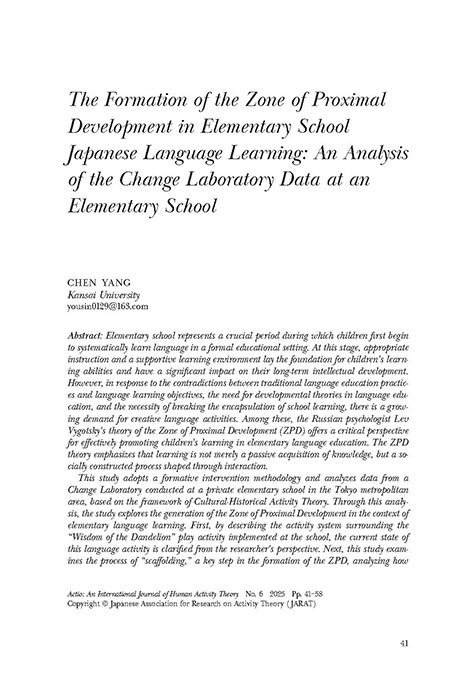
Abstract
Reference

Abstract
Elementary school represents a crucial period during which children first begin to systematically learn language in a formal educational setting. At this stage, appropriate instruction and a supportive learning environment lay the foundation for children’s learning abilities and have a significant impact on their long-term intellectual development. However, in response to the contradictions between traditional language education practices and language learning objectives, the need for developmental theories in language education, and the necessity of breaking the encapsulation of school learning, there is a growing demand for creative language activities. Among these, the Russian psychologist Lev Vygotsky’s theory of the Zone of Proximal Development (ZPD) offers a critical perspective for effectively promoting children’s learning in elementary language education. The ZPD theory emphasizes that learning is not merely a passive acquisition of knowledge, but a socially constructed process shaped through interaction.
This study adopts a formative intervention methodology and analyzes data from a Change Laboratory conducted at a private elementary school in the Tokyo metropolitan area, based on the framework of Cultural-Historical Activity Theory. Through this analysis, the study explores the generation of the Zone of Proximal Development in the context of elementary language learning. First, by describing the activity system surrounding the “Wisdom of the Dandelion” play activity implemented at the school, the current state of this language activity is clarified from the researcher’s perspective. Next, this study examines the process of “scaffolding,” a key step in the formation of the ZPD, analyzing how children, with guidance from adults or through collaboration with more capable peers, develop from their current level of performance toward a potential level of development in language learning. Furthermore, the study analyzes the structural stages of the ZPD observed during the “Wisdom of the Dandelion” activity and discusses the realization of the cyclical structure of these developmental stages. Finally, this study seeks to offer new perspectives on traditional approaches to language learning in elementary education.
References
Brown, A. L., & French, L. A. (1979). The zone of proximal development: Implications for intelligence testing in the year 2000. Intelligence, 3, 255–277.
Cazden, C. B. (1981). Performance before competence: Assistance to child. discourse in the zone of proximal development. The Quarterly Newsletter of the Laboratory of Comparative Human Cognition, 3(1), 5–8.
Engeström, Y. (1987/2015). Learning by expanding: An activity-theoretical. approach to developmental research (2nd ed.). Cambridge: Cambridge University Press.
Engeström, Y. (2016). Studies in expansive learning: Learning what is not yet there. New York: Cambridge University Press.
Griffin, P., & Cole, M. (1984). Current activity for the future: The Zo-ped. In. Rogoff, B. & Wertsch, J. V. (Eds.), Children’s learning in the “zone of proximal development” (pp. 60–64). San Francisco: Jossey-Bass.
Rogoff, B., & Wertsch, J. V. (Eds.). (1984). Children’s learning in the “zone of proximal development”. San Francisco: Jossey-Bass.
Virkkunen, J., & Ahonen, H. (2011). Supporting expansive learning through theoreticalgenetic reflection in the Change Laboratory. Journal of Organizational Change Management, 24(2), 229–243.
Vygotsky, L. S. (1978). Mind in society: The development of higher psychological processes. Cambridge, MA: Harvard University Press.
魏戈(2023). 最近发展区:理论根脉、概念要义与育人价值. 教育研究, 5, 66–76.
Wood, D. J. (1980). Teaching the young child: Some relationships between social interaction, language, and thought. In D. R. Olson (Ed.), The social foundations of language and thought (pp. 280–298). New York: Norton.
Wood, D., Bruner, J. S., & Ross, G. (1976). The role of tutoring in problem solving. Journal of Child Psychology and Psychiatry, 17, 89–100.